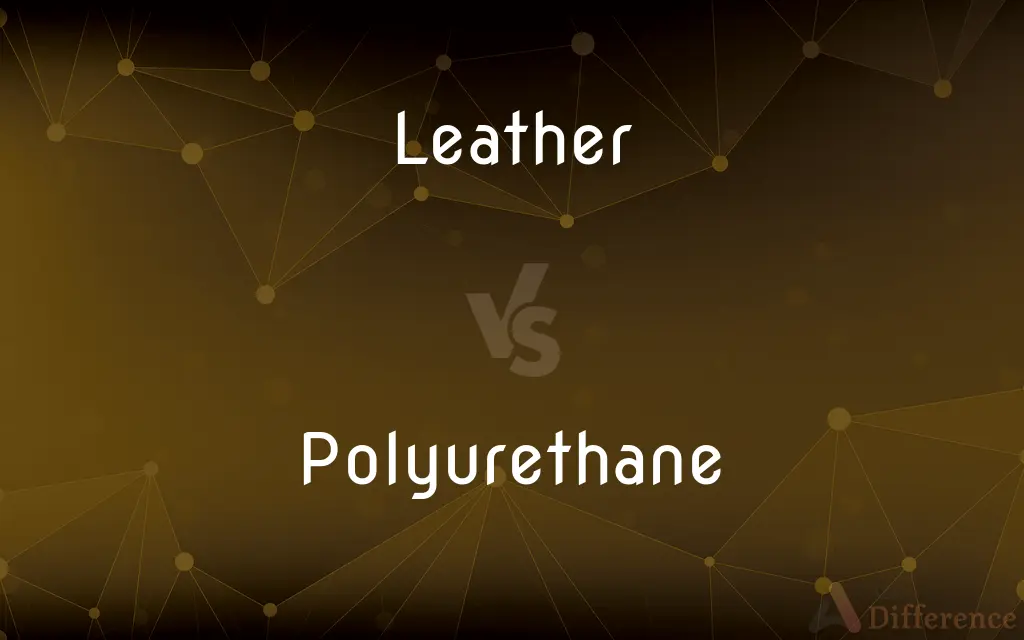Leather vs. Polyurethane — What's the Difference?
By Tayyaba Rehman — Updated on September 23, 2023
Leather is a natural material made from animal hide, while polyurethane is a synthetic polymer used in various applications, including as a faux leather.

Difference Between Leather and Polyurethane
Table of Contents
ADVERTISEMENT
Key Differences
Leather and polyurethane are materials often compared due to their similar uses in products, especially in fashion and upholstery. Leather, being of natural origin, is derived from the processed hides of animals, primarily cows. It's prized for its durability, texture, and natural aesthetic.
On the other hand, polyurethane, commonly abbreviated as PU, is a type of plastic polymer. In context, when it's used to mimic the appearance and feel of leather, it's often called "PU leather" or "faux leather." Polyurethane is a versatile material, used not just as a leather substitute but also in foams, coatings, and adhesives.
The production processes of leather and polyurethane are vastly different. Leather production involves the tanning of animal hides, a method that preserves, colors, and conditions the skin. Polyurethane, being synthetic, is created through chemical reactions between polyol and diisocyanate.
When it comes to their environmental impact, both materials have their concerns. Leather production can have significant ecological implications due to deforestation for cattle farming and the chemicals used in tanning. Polyurethane production involves the use of petrochemicals, and its degradation is much slower compared to natural materials.
In terms of care, maintenance, and lifespan, leather often requires more attentive care to retain its appearance but can last many years if well-maintained. Polyurethane, while less demanding in care, might not have the same longevity, especially when used as faux leather, which can crack or peel over time.
ADVERTISEMENT
Comparison Chart
Origin
Natural (animal hides)
Synthetic (polymer)
Common Uses
Clothing, shoes, furniture, bags
Faux leather, foams, coatings, adhesives
Production Process
Tanning of animal hides
Chemical reactions between polyol and diisocyanate
Environmental Impact
Deforestation, tanning chemicals
Petrochemical use, slow degradation
Lifespan & Care
Requires maintenance, long-lasting
Less demanding care, can degrade faster
Compare with Definitions
Leather
Natural and breathable material.
Leather shoes provide excellent comfort.
Polyurethane
A versatile synthetic polymer.
The polyurethane foam provided excellent cushioning.
Leather
Prized for its unique textures and patterns.
The leather wallet had a distinct grain pattern.
Polyurethane
Used as faux leather material.
The polyurethane jacket looked almost like real leather.
Leather
A material made from tanned animal hides.
Genuine leather jackets often age gracefully.
Polyurethane
Resistant to wear and abrasion.
The polyurethane coating on the floor made it durable.
Leather
Used in premium fashion and upholstery.
The leather sofa added a touch of luxury to the living room.
Polyurethane
Derived from petrochemicals.
Many are researching greener alternatives to traditional polyurethane.
Leather
Often requires conditioning and care.
To retain its shine, the leather bag needs regular conditioning.
Polyurethane
Can be flexible or rigid based on formulation.
Rigid polyurethane is used in some insulation materials.
Leather
Leather is a strong, flexible and durable material obtained from the tanning, or chemical treatment, of animal skins and hides to prevent decay. The most common leathers come from cattle, sheep, goats, equine animals, buffalo, pigs and hogs, and aquatic animals such as seals and alligators.Leather can be used to make a variety of items, including clothing, footwear, handbags, furniture, tools and sports equipment, and lasts for decades.
Polyurethane
Polyurethane (often abbreviated PUR and PU) is a polymer composed of organic units joined by carbamate (urethane) links. In contrast to other common polymers such as polyethylene and polystyrene, polyurethane is produced from a wide range of starting materials (monomers) and is therefore a class of polymers, rather than a distinct compound.
Leather
A material made from the skin of an animal by tanning or a similar process
A leather jacket
Polyurethane
A synthetic resin in which the polymer units are linked by urethane groups, used chiefly as constituents of paints, varnishes, adhesives, and foams
Five coats of polyurethane
Polyurethanes serve a variety of uses
Leather
A piece of leather as a polishing cloth.
Polyurethane
Coat with polyurethane paint or varnish
The sanded and polyurethaned floorboards
Leather
Short for stirrup leather
Polyurethane
Any of various thermoplastic isocyanate polymers, widely varying in flexibility, used in tough chemical-resistant coatings, adhesives, and foams.
Leather
Beat or thrash (someone)
He caught me and leathered me black and blue
Polyurethane
(organic chemistry) Any of various polymeric resins containing urethane links; used in very many industrial and domestic applications.
Leather
The dressed or tanned hide of an animal.
Polyurethane
Any polymer containing [-NH.CO.O-] linkages; such polymers are much used as the basis of light but rigid foams for packaging (polyurethane foam) and for hard coatings, as on floors.
Leather
Any of various articles or parts made of dressed or tanned hide, such as a boot or strap.
Polyurethane
Any of various polymers containing the urethane radical; a wide variety of synthetic forms are made and used as adhesives or plastics or paints or rubber
Leather
The flap of a dog's ear.
Leather
To cover wholly or in part with the dressed or tanned hide of an animal.
Leather
(Informal) To beat with a strap made of hide.
Leather
Made of, relating to, or resembling dressed or tanned animal hide.
Leather
(Slang) Of or relating to the wearing of leather, or patronized by people who wear leather, especially as a sexual fetish
A leather bar.
Leather
A tough material produced from the skin of animals, by tanning or similar process, used e.g. for clothing.
Leather
A piece of the above used for polishing.
Leather
(colloquial) A cricket ball or football.
Leather
(plural: leathers) clothing made from the skin of animals, often worn by motorcycle riders.
Leather
(baseball) A good defensive play
Leather
(boxing) A punch.
Leather
The skin.
Leather
Made of leather.
Leather
Referring to one who wears leather clothing (motorcycle jacket, chaps over 501 jeans, boots), especially as a sign of sadomasochistic homosexuality.
Leather
(transitive) To cover with leather.
Leather
(transitive) To strike forcefully.
Leather
(transitive) To spank or beat with a leather belt or strap.
Leather
The skin of an animal, or some part of such skin, with the hair removed, and tanned, tawed, or otherwise dressed for use; also, dressed hides, collectively.
Leather
The skin.
Leather
To beat, as with a thong of leather.
Leather
Of, pertaining to or made of leather; consisting of leather; as, a black leather jacket.
Leather
An animal skin made smooth and flexible by removing the hair and then tanning
Common Curiosities
Can polyurethane be used as a leather substitute?
Yes, polyurethane is often used as "faux leather" or "PU leather."
Does leather require special care?
Yes, leather often requires conditioning and protection to maintain its appearance.
Is leather a natural material?
Yes, leather is a natural material derived from animal hides.
Which is more durable, leather or polyurethane?
Leather is generally more durable, but polyurethane can be wear-resistant based on its formulation.
How is leather produced?
Leather is produced by tanning animal hides.
Is polyurethane biodegradable?
Polyurethane is less biodegradable than natural materials like leather.
Can polyurethane mimic the feel of real leather?
Yes, some high-quality polyurethanes can closely mimic the feel of leather.
Share Your Discovery

Previous Comparison
Smart vs. Clever
Next Comparison
Somersault vs. CartwheelAuthor Spotlight
Written by
Tayyaba RehmanTayyaba Rehman is a distinguished writer, currently serving as a primary contributor to askdifference.com. As a researcher in semantics and etymology, Tayyaba's passion for the complexity of languages and their distinctions has found a perfect home on the platform. Tayyaba delves into the intricacies of language, distinguishing between commonly confused words and phrases, thereby providing clarity for readers worldwide.
















































